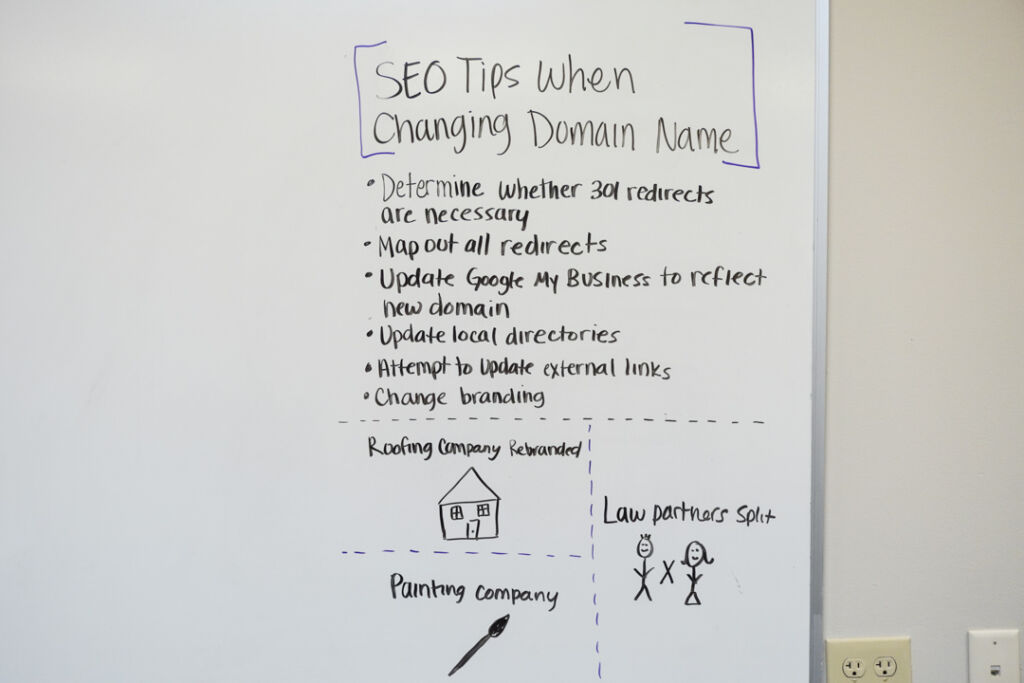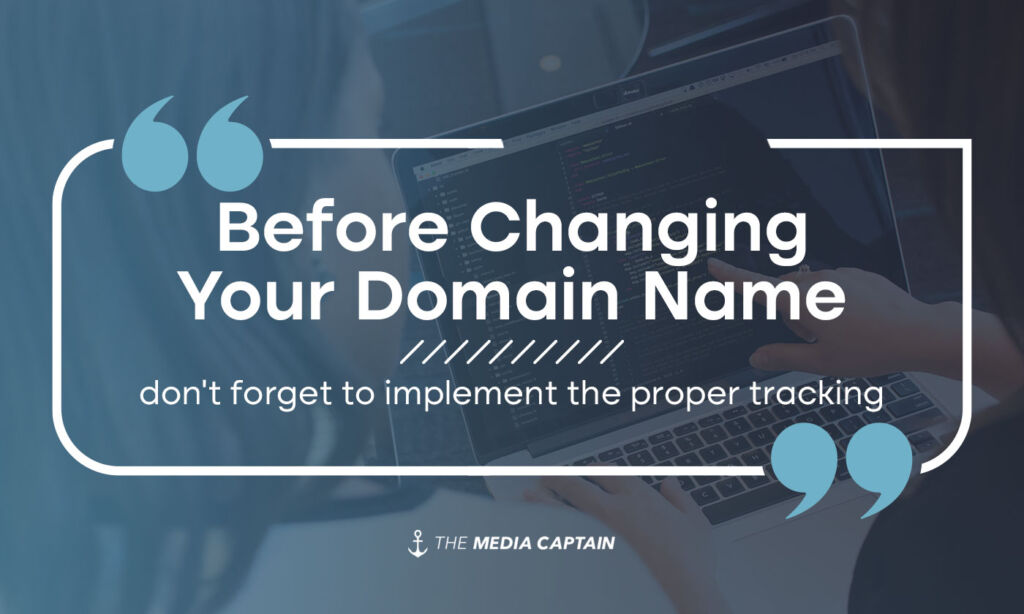Key Points for Article on SEO Tips When Changing Domain Name:
- Determine whether 301 redirects are necessary
- Map out all redirects
- Change Internal Links to Reflect New Domain
- Update Google My Business and Social Channels
- Update Local Directories
- Attempt to Update External Links
- Change Branding
Real-Life Examples
Below are client scenarios that required a change of domain name along with SEO assistance from our firm. If you are reading this article, your business is likely in a similar boat:
- A law firm client informed us that their partners were splitting into two separate firms. Their domain name included both of the attorney names (example: jonesandsmith.com) so a new domain needed to be created for each attorney site.
- Note: The attorney that owned the original domain name was obviously the beneficiary as they were able to redirect the original domain name. The other attorney had to start from scratch with a new domain name.
- An established roofing company shortened the name of their company and rebranded.
- Note: This was fairly simple as we 301 redirected the original URlL into the new URL. This roofing company later went on to acquire a much smaller roofing company in another market. We determined the smaller company had negative SEO on its site and redirecting that site actually caused more harm than good so we deleted the other domain name and opted against the redirect.
- Poor SEO and negative reviews made a painting company decide to rebrand entirely.
- Note: In this scenario, we did not conduct a 301 redirect. We did a 404 on their original site to distance this company from the poor SEO of the prior site along with the bad reviews. According to WebFX, a 404 Page Not Found means the server that holds a website isn’t showing the website. In layman’s terms, you are nuking the site or the page.
Related Video: Merging Website and Conducting Redirects After Merger or Acquisition
SEO Checklist to Follow When Changing Domain Name:
- Decide on a Good Domain Name
- There’s a strong likelihood you are handcuffed with your current domain name, which is a reason you are having to change. Whether you are splitting up from a business partner, rebranding, or need a clean slate, this is your chance to start fresh. Make sure when selecting a domain name, you choose one that’s good for SEO. You also want to make sure your domain name positions your business for future growth. For example, don’t include plumbing in your domain name if you’ll be offering HVAC in the future.
- Redirect old domain name to new domain name to carryover SEO
- If you are fortunate enough to have ownership of the old domain name and there is SEO strength behind it, by all means, redirect it properly to your new domain name. Rather than starting from scratch with your SEO, the permanent redirect will allow you to carry over the power from the previous site. It’s important to note that you shouldn’t just do a 301 redirect of the entire domain. Create a redirect map that does an apple to apple redirect on all similar pages.
- More Info on Redirect Mapping: If you acquired a roofing company in your own local market, you would redirect the siding page from the acquired companies page to the similar page on your existing site. If you acquired a roofing company in another market, you would create new pages for that local market and conduct the redirect to those city-specific pages.
- More Info on Redirect Mapping: If you acquired a roofing company in your own local market, you would redirect the siding page from the acquired companies page to the similar page on your existing site. If you acquired a roofing company in another market, you would create new pages for that local market and conduct the redirect to those city-specific pages.
- If you are fortunate enough to have ownership of the old domain name and there is SEO strength behind it, by all means, redirect it properly to your new domain name. Rather than starting from scratch with your SEO, the permanent redirect will allow you to carry over the power from the previous site. It’s important to note that you shouldn’t just do a 301 redirect of the entire domain. Create a redirect map that does an apple to apple redirect on all similar pages.
- Rebrand with new logo to reflect new brand name
- If you are moving to a new domain, in most instances, you will need to rebrand. You don’t need to spend thousands of dollars on a new logo for a rebrand. This can be done by hiring a graphic designer for several hours [learn about our design process]. You will need a new logo to reflect your new domain name. You will also want to find all references on the website that mention the old brand name and change this out.
- Change all internal links from old URL to new URL so there aren’t broken links on the site
- You don’t want all of your internal links 301 redirecting. If you have a WordPress site, you can utilize THIS PLUGIN to update URLs in posts and pages, excerpts, image attachments, custom fields, etc. If you don’t have a WordPress site and you share the link with your developer, they’ll know how to do this within your site.
- Note: If you need development support, you can contact our firm for assistance!
- You don’t want all of your internal links 301 redirecting. If you have a WordPress site, you can utilize THIS PLUGIN to update URLs in posts and pages, excerpts, image attachments, custom fields, etc. If you don’t have a WordPress site and you share the link with your developer, they’ll know how to do this within your site.
- Change name on Google My Business page and Social Channels
- We’re now moving off of your website. It’s important when changing a domain and the name of your business that you get this updated in Google My Business. You will have to change your business name along with the URL and any other reference of the old domain name or brand name. You will want to take a similar approach for your core social media channels, such as Facebook, Instagram, Yelp, Twitter and others. A good rule of thumb is to do a Google Search for your brand name and scroll through the first 10 pages (100 results) to find as many sites that as possible that you can edit.
- Get your domain name updated in a local directory aggregator
- If you are unfamiliar with Yext or Moz Local, they are directory aggregators that submit your business information to hundreds of sites. If you were ever curious how your business information got on Waze or MapQuest, many times it’s through a data aggregator. There are arguments on doing manual submissions for citations versus aggregator submissions. While the manual submission can save you money, the citation saves you time. In an instance when you change your domain name, it’s nice to simply update your domain name in one spot and then have it update across hundreds of sites versus having to go in manually and change them one by one. It’ll be very important for your local SEO to get the proper domain name reflected in local directories.
- Change as many external links as possible
- If there are external websites linking to your site, try and get as many of them changed as possible. This will require outreach and is a tedious process but avoiding 301 redirects in your links is the cleaner route to take.
Below is a picture of our whiteboard where we listed out the tips needed when changing your domain name to carry over SEO!
Don’t Forget About Tracking
Prior to changing your domain name, don’t forget to implement the proper tracking.
You’ll want to utilize a software like SEMRush or Moz to track your keyword rankings on Google. You should have benchmarks for where the previous domain was ranking for coveted keywords prior to launching your new domain name. You’ll want to save the past set of rankings prior to launching the new domain so you have a benchmark to compare to. You will then create the new domain to track within SEMRush or Moz so you can run a comparison between the old domains rank versus the new domain. Don’t panic though if you see a dramatic drop in your keyword rank. It can take time for your keywords to return to normalcy after redirecting a site so don’t panic if this takes 2-3 weeks of time.
If you want to consult an expert on properly changing your domain to make sure SEO is properly carried over, feel free to contact our firm. If you plan on implementing this yourself, we hope you find the steps above helpful based on your scenario and situation.





